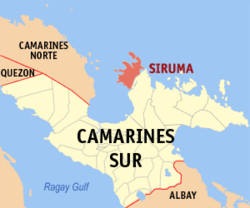Siruma | |
|---|---|
| Municipality of Siruma | |
 View from Siruma View Deck | |
 Map of Camarines Sur with Siruma highlighted | |
Location within the Philippines | |
| Coordinates: 14°01′19″N123°15′32″E / 14.0219°N 123.2589°E | |
| Country | Philippines |
| Region | Bicol Region |
| Province | Camarines Sur |
| District | 4th district |
| Barangays | 22 (see Barangays) |
| Government | |
| • Type | Sangguniang Bayan |
| • Mayor | Carina R. Polinga |
| • Vice Mayor | Sandy S. Ondis |
| • Representative | Arnulf Bryan B. Fuentebella |
| • Municipal Council | Members |
| • Electorate | 14,979 voters (2025) |
| Area | |
• Total | 141.27 km2 (54.54 sq mi) |
| Elevation | 11 m (36 ft) |
| Highest elevation | 134 m (440 ft) |
| Lowest elevation | −1 m (−3.3 ft) |
| Population (2024 census) [3] | |
• Total | 19,168 |
| • Density | 135.68/km2 (351.42/sq mi) |
| • Households | 4,262 |
| Economy | |
| • Income class | 4th municipal income class |
| • Poverty incidence | 49.7 |
| • Revenue | ₱ 145 million (2022) |
| • Assets | ₱ 199.5 million (2022) |
| • Expenditure | ₱ 111.1 million (2022) |
| • Liabilities | ₱ 9.931 million (2022) |
| Service provider | |
| • Electricity | Camarines Sur 2 Electric Cooperative (CASURECO 2) |
| Time zone | UTC+8 (PST) |
| ZIP code | 4427 |
| PSGC | |
| IDD : area code | +63 (0)54 |
| Native languages | Central Bikol Tagalog |
| Crime index | 0 |
| Website | crohan |
Siruma, officially the Municipality of Siruma (Central Bikol : Banwaan kan Siruma; Tagalog : Bayan ng Siruma), is a municipality in the province of Camarines Sur, Philippines. According to the 2024 census, it has a population of 19,168 people. [5]



